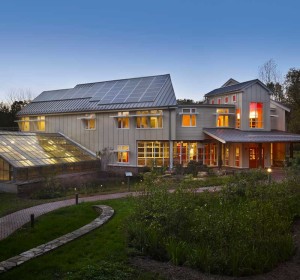Stroud Water Research Center building achieves highest green-building honor

The Moorhead Environmental Complex at the Stroud Water Research Center in Avondale has received the nation’s highest ranking for green building. Photo courtesy of Halkin Mason Photography
In keeping with the spirit of Earth Day, the Stroud Water Research Center in Avondale announced a major global-friendly achievement on Monday.
Its Moorhead Environmental Complex, which opened in the fall, has received the nation’s highest certification for green construction: LEED (Leadership in Energy and Environmental Design) Platinum, said a news release from the center.
“We’re delighted to have achieved LEED Platinum, the highest honor in LEED certification,” Bernard W. Sweeney, Stroud’s director and senior research scientist, said in the release. “The Moorhead Environmental Complex was a huge undertaking. It combined creative, cutting-edge architectural and mechanical design with other innovative environmental approaches like ‘getting the water right,’ which became our guiding principle in pursuit of a new green building for environmental education and public outreach that would model sustainable practices for managing water.”
Since 1967, the center has been pioneering research in the field of freshwater science; that work has yielded valuable insights into how streams and rivers function and how their health can be impaired as well as restored and preserved. As companions to its research, the center has also developed education and watershed restoration programs to advance knowledge and stewardship of freshwater, the release said.
While the Moorhead Environmental Complex houses the center’s departments of education, watershed restoration, development, communications, facilities, and administration, it also serves as a teaching tool, providing opportunities for educators to discuss the various features such as wetland treatment of wastewater, rainwater capture, and photovoltaic panels.
“The green building movement offers an unprecedented opportunity to respond to the most important challenges of our time, including global climate change, dependence on non-sustainable and expensive sources of energy and threats to human health,” said Rick Fedrizzi, president, chief executive officer and founding chair of the U.S. Green Building Council. “The work of innovative building projects such as the Moorhead Environmental Complex is a fundamental driving force in the green building movement.”
LEED certification of the Moorhead Environmental Complex was based on a number of green design and construction features that positively impact the project itself and the broader community, the release said. Some of the green features on site include: storm water management using natural landscaping with porous surfaces, a green roof, composting toilets, a geothermal radiant heating and cooling system, and soy-based, spray-foam insulation.
“With two new classrooms, educational signage, and the green features that our educators can utilize as teaching tools, school and community groups who come to the center will learn not just about environmental science but also environmental stewardship and how they too can be a part of the solution,” said Susan Gill, education director.
To learn more about the Stroud Water Research Center, a nonprofit that seeks to advance knowledge and stewardship of freshwater, visit http://www.stroudcenter.org/mec/.






